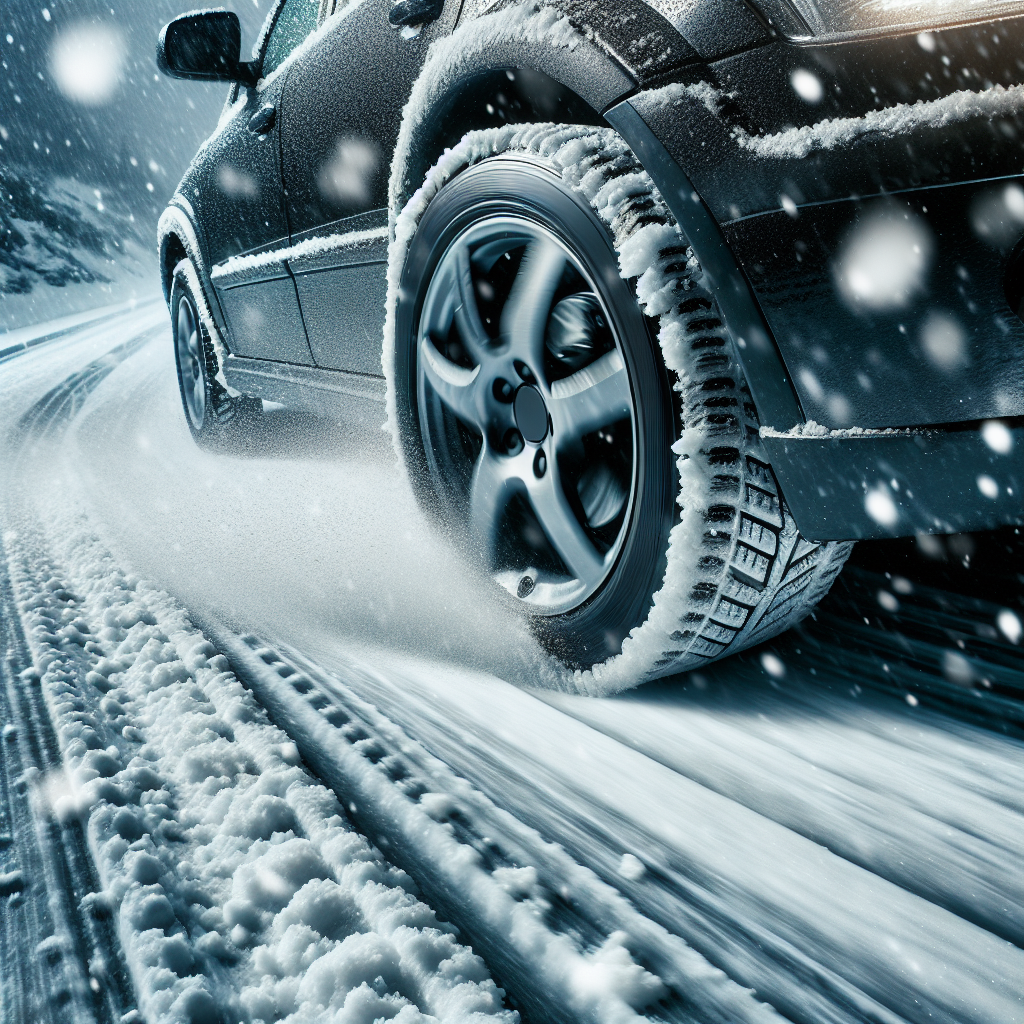You may be wondering how winter tires handle cornering and maneuverability. Well, in this article, we will explore the characteristics of winter tires that make them excel in snowy and icy conditions. From their unique tread design to specialized rubber compounds, winter tires are specifically engineered to provide optimal grip and control when navigating twists and turns on slippery roads. So, whether you’re a seasoned winter driver or planning your first snowy adventure, read on to discover how winter tires can enhance your vehicle’s performance and keep you safe during those chilly months.

Factors Affecting Cornering and Maneuverability
When it comes to cornering and maneuverability, several factors play a crucial role in determining how well your vehicle can handle these tasks. From tire tread design to tire pressure, each element contributes to the overall performance of your vehicle on the road. By understanding these factors, you can make informed decisions when choosing the right tires for your driving needs.
Tire Tread Design
One of the primary factors influencing cornering and maneuverability is the tread design of your tires. The tread design determines the pattern and depth of the grooves on the tire’s surface, which directly affects traction and grip. Tires with a more aggressive tread pattern, featuring deeper grooves and larger blocks, tend to provide better traction during cornering and maneuvering situations.
Tread Compound
The tread compound of your tires also plays a significant role in cornering and maneuverability. The compound refers to the type of rubber used in the tire’s construction. Winter tires, for example, typically use a softer rubber compound that remains flexible even in cold temperatures. This enhanced flexibility allows the tire to conform to the road surface, providing better grip and control.
Tire Width and Aspect Ratio
The width and aspect ratio of your tires can impact cornering and maneuverability as well. Wider tires generally offer increased grip while cornering, as they provide a larger contact patch with the road. A wider tire spreads the weight of the vehicle more evenly, ensuring better stability during turns. Additionally, the aspect ratio, which represents the tire’s sidewall height as a percentage of its width, affects the tire’s ability to resist lateral forces during cornering.
Tire Pressure
Proper tire pressure is crucial for optimal cornering and maneuverability. Underinflated tires can affect the tire’s contact with the road, reducing grip and stability. On the other hand, overinflated tires can lead to a decreased contact patch, resulting in poor traction. It is essential to regularly check and maintain the recommended tire pressure specified by the vehicle manufacturer to ensure safe and efficient cornering.
Tire Type
Different types of tires also have an impact on cornering and maneuverability. Winter tires, specifically designed for cold weather conditions, offer numerous benefits that enhance cornering performance. Compared to all-season tires, winter tires have a unique tread pattern and rubber compound that allows for better traction on snow and ice. Understanding the advantages of winter tires can help you make an informed decision when choosing tires for winter driving.
Benefits of Winter Tires for Cornering and Maneuverability
Winter tires, also known as snow tires, are specifically designed to enhance your vehicle’s performance in cold weather conditions. These tires offer several benefits that significantly improve cornering and maneuverability, providing you with a safer and more controlled driving experience.
Enhanced Grip on Snow and Ice
The primary advantage of winter tires is their superior grip on snowy and icy roads. The tread design of winter tires incorporates more aggressive patterns, including deep grooves and prominent sipes. These features allow the tire to bite into the snow, effectively improving traction and reducing the risk of skidding during cornering. With winter tires, you can feel confident while navigating through snowy and icy roads.
Improved Handling in Cold Temperatures
Winter tires are also designed to maintain their performance in extremely cold temperatures. The rubber compound used in winter tires remains pliable and flexible, even in freezing conditions. This flexibility allows the tires to conform to the road surface, ensuring optimal grip and control during cornering maneuvers. Unlike all-season tires, which can harden in cold temperatures, winter tires maintain their traction and handling capabilities.
Reduced Braking Distances
In addition to enhanced grip, winter tires also contribute to shorter braking distances. The unique tread design and softer rubber compound of winter tires allow them to bite into the snow or ice, providing reliable stopping power. This reduced braking distance is essential for quick and safe cornering, preventing accidents and ensuring your safety on wintry roads.
Better Traction in Wet Conditions
While winter tires are specifically designed for snowy and icy conditions, they also offer advantages in wet conditions. The tread design of winter tires typically incorporates wider grooves, which effectively evacuate water from the tire’s contact patch. This reduces the risk of hydroplaning and improves traction on wet roads, enhancing your vehicle’s cornering and maneuverability abilities.
Effect of Winter Tire Tread Design on Cornering and Maneuverability
The tread design of winter tires plays a vital role in the tire’s overall performance during cornering and maneuvering. Different tread patterns offer various benefits, allowing you to choose the one best suited for your driving needs in winter conditions.
Sipes and Grooves
Winter tires often feature an abundance of sipes and grooves on their tread surface. Sipes are tiny slits that create additional edges on the tire’s surface, enhancing grip on icy and snowy roads. These sipes help to channel away water and improve traction, contributing to better cornering capabilities. The grooves work in conjunction with the sipes to provide additional grip and dispersal of loose snow or slush, further enhancing the tire’s performance while maneuvering.
Directional Tread Patterns
Directional tread patterns are commonly found on winter tires. These patterns feature V-shaped grooves that point in the direction of tire rotation. The main advantage of directional tread patterns is their ability to effectively channel water, snow, and slush away from the tire’s contact patch. By doing so, directional tread patterns enhance traction and grip, allowing for better cornering and maneuvering even in adverse winter conditions.
Multidirectional Tread Patterns
Multidirectional tread patterns, also known as asymmetric or non-directional tread patterns, offer versatility and performance in various winter conditions. These patterns incorporate a combination of larger blocks, grooves, and sipes that provide optimal grip and stability. The multidirectional design allows for effective water evacuation, while the larger blocks offer enhanced traction during cornering maneuvers. This tread design is popular among winter tires due to its ability to deliver reliable performance in a range of winter driving scenarios.
Studless vs Studded Tires
When considering winter tires, you may come across the choice between studless and studded tires. Studless winter tires are designed to provide optimal grip on icy and snowy roads without the use of metal studs. These tires rely on their tread pattern, sipes, and special rubber compounds to deliver excellent traction and performance. On the other hand, studded winter tires feature small metal studs embedded in the tread, further enhancing grip on icy surfaces. While studded tires offer superior traction on ice, they may produce more tire noise and are typically restricted or banned in some areas due to their potential to damage road surfaces.
Influence of Tread Compound on Cornering and Maneuverability
The composition of the rubber compound used in winter tires significantly affects their cornering and maneuvering abilities. The choice of tread compound can greatly impact traction, grip, and flexibility, especially in cold weather conditions.
Soft Rubber Compounds
Winter tires are constructed using softer rubber compounds compared to all-season or summer tires. The soft rubber remains flexible, even in extremely cold temperatures, allowing the tire to conform to the road surface. This flexibility ensures better grip during cornering and maneuvering, reducing the risk of skidding or losing control of the vehicle. The softer rubber compound of winter tires also provides enhanced grip on icy and snowy surfaces, further enhancing their cornering performance.
Silica-Infused Compounds
Many modern winter tires incorporate silica-infused compounds in their construction. Silica is added to the tire compound to enhance its grip and flexibility in cold temperatures. Silica-infused compounds offer improved traction and handling in winter conditions, allowing for better cornering and maneuverability. Additionally, silica compounds also contribute to reduced rolling resistance, which can enhance fuel efficiency and extend the tread life of the tire.
Rubber Flexibility in Cold Temperatures
The overall flexibility of the rubber compound in winter tires during cold temperatures is crucial for optimal cornering and maneuverability. Even with a suitable tread design, a tire with a rigid or less flexible rubber compound may not offer optimum grip and traction. Winter tires’ rubber compounds are specifically formulated to maintain flexibility in freezing conditions, ensuring reliable performance in cornering and maneuvering maneuvers.

Role of Tire Width and Aspect Ratio in Cornering and Maneuverability
The width and aspect ratio of your tires influence not only the aesthetics but also the cornering and maneuvering capabilities of your vehicle. Choosing the right tire width and aspect ratio is essential for achieving optimal grip and stability during turns.
Wider Tires for Increased Grip
Wider tires generally offer increased grip and traction during cornering. The wider contact patch created by wider tires allows for better distribution of weight, improving stability and control. This increased grip helps the tire maintain its grip on the road, allowing for better cornering and maneuvering at higher speeds. However, it is important to ensure that the chosen width of the tire is compatible with the vehicle’s specifications and wheel well clearances to avoid any interference or performance issues.
Optimal Aspect Ratio for Stability
The aspect ratio of a tire refers to the height of the sidewall expressed as a percentage of the tire’s width. For cornering and maneuverability, an optimal aspect ratio is crucial to ensure stability. Tires with a lower aspect ratio tend to provide better lateral stability during cornering. The lower sidewall height reduces flex and sidewall squirm, resulting in improved responsiveness and sharper cornering capabilities. However, it is important to consider that lower aspect ratios may also result in a firmer ride quality, as there is less cushioning provided by the sidewall.
Impact of Tire Pressure on Cornering and Maneuverability
Proper tire pressure is vital for cornering and maneuverability, as it directly affects the tire’s contact patch, grip, and stability. Maintaining the recommended tire pressure is crucial to ensure optimum performance and safety while driving.
Achieving Recommended Tire Pressure
To achieve the recommended tire pressure, refer to your vehicle’s owner’s manual or the label located on the driver’s side door jamb. The recommended tire pressure may vary depending on the vehicle make and model, as well as the type and size of tires used. Use a reliable tire pressure gauge to monitor and adjust the tire pressure as needed, ensuring that all tires are inflated to the correct pressure. Regularly checking and maintaining the recommended tire pressure allows for better cornering and maneuverability, as it provides the tire with the ideal contact patch and load-bearing capability.
Effects of Overinflation and Underinflation
Both overinflation and underinflation can negatively impact cornering and maneuverability. Overinflated tires reduce the contact patch, resulting in decreased grip and stability during turns. This can cause the vehicle to feel more sensitive to steering inputs, potentially leading to oversteer or loss of control. On the other hand, underinflated tires increase the contact patch but also increase tire flex, reducing stability and responsiveness during cornering. Additionally, underinflated tires generate more heat and have an increased risk of failure, compromising overall safety. It is essential to monitor and maintain the recommended tire pressure to optimize cornering and maneuvering performance.

Comparison of All-Season Tires and Winter Tires for Cornering and Maneuverability
When it comes to cornering and maneuverability in winter conditions, winter tires outperform all-season tires due to their specialized design and construction. Understanding the key differences between these two tire types can help you make an informed decision for your specific driving needs.
Differences in Tread Design
The tread design is one of the most significant differences between all-season tires and winter tires. All-season tires are designed to provide decent performance in various weather conditions, making them a suitable choice for temperate climates. However, the tread design of all-season tires cannot match the performance of dedicated winter tires in snow and ice. Winter tires feature deeper grooves, larger blocks, and specialized siping for enhanced grip and traction on wintry roads.
Different Rubber Compounds
Another notable difference between all-season tires and winter tires is the rubber compound used in their construction. All-season tires use a rubber compound that is designed to offer a balance between performance and longevity in different weather conditions. In contrast, winter tires utilize a softer rubber compound that remains flexible in extremely cold temperatures. The soft rubber compound of winter tires ensures optimal grip and traction, which is vital for safe cornering and maneuvering on snow and ice.
Varying Performance in Cold Temperatures
While all-season tires may provide adequate performance in mild winter conditions, they often fall short when it comes to extreme cold temperatures. All-season tires tend to harden in freezing temperatures, reducing their grip and responsiveness. On the other hand, winter tires are engineered to excel in cold weather, maintaining their pliability and grip even in sub-zero conditions. The superior performance of winter tires in extremely cold temperatures ensures better cornering and maneuverability, providing you with increased control and safety.
Factors to Consider for Optimal Cornering and Maneuverability
Beyond the characteristics of your tires, several other factors can influence cornering and maneuverability. Considering these factors and making necessary adjustments can further enhance your vehicle’s performance, ensuring safer and more enjoyable driving experiences.
Driving Skill and Technique
Your driving skill and technique play a significant role in cornering and maneuverability. Properly positioning your vehicle before a turn, utilizing the appropriate steering and braking techniques, and maintaining smooth and controlled inputs are essential for optimal cornering. Developing and honing your driving skills can greatly improve your ability to safely navigate corners and maneuver your vehicle.
Road Conditions
Road conditions have a direct impact on cornering and maneuverability. Wet, icy, or snowy roads can significantly reduce grip and increase the risk of sliding or losing control. It is crucial to adjust your driving style and slow down when encountering adverse road conditions. Be aware of potential hazards, such as black ice or slush, and adapt your driving accordingly to ensure safe cornering and maneuvering.
Speed and Aggressiveness
The speed at which you approach corners and the level of aggressiveness in your driving behavior can affect cornering and maneuverability. Excessive speed or aggressive maneuvers increase the risk of losing control, especially in challenging road conditions. Slowing down and maintaining appropriate speed limits while considering the road conditions can enhance your ability to safely navigate corners and maneuver your vehicle with ease.

Importance of Proper Maintenance for Cornering and Maneuverability
Proper maintenance of your tires is essential for ensuring optimal cornering and maneuverability. Regular inspections, rotation, alignment, and timely replacement of worn tires are key maintenance practices that contribute to safer and more efficient driving experiences.
Regular Tire Inspections
Regular tire inspections are vital for identifying any signs of damage or wear. Inspect the tread depth, looking for uneven wear patterns or tire damage such as cuts or bulges. Additionally, ensure that all tires are inflated to the recommended tire pressure to maintain optimal performance. Regular inspections allow you to detect and address any issues promptly, ensuring the safety and performance of your tires during cornering and maneuvering.
Rotation and Alignment
Tire rotation and alignment are important maintenance practices that help maintain even tread wear and ensure proper tire performance. Regularly rotating your tires allows for balanced wear across all four tires, improving traction and handling during cornering. Wheel alignment ensures that the tires are properly aligned with each other and the vehicle’s specifications. Proper alignment optimizes tire contact with the road, improving cornering performance and extending the lifespan of your tires.
Replacing Worn Tires
Worn tires can significantly compromise cornering and maneuverability performance. As tires wear down, the tread depth decreases, reducing grip and traction on the road. It is crucial to monitor the tread depth regularly and replace tires once they reach the recommended minimum depth. By replacing worn tires, you can ensure maximum grip and control during cornering and maneuvering, maintaining your safety on the road.
Conclusion
Cornering and maneuverability are vital aspects of safe and enjoyable driving experiences. Various factors, including tire tread design, tread compound, tire width, aspect ratio, tire pressure, and tire type, all play a significant role in determining how well your vehicle can handle corners and maneuvers. Winter tires, with their specialized design and construction, offer numerous benefits that enhance cornering and maneuverability, such as enhanced grip on snow and ice, improved handling in cold temperatures, reduced braking distances, and better traction in wet conditions. Understanding these factors and considering them when choosing and maintaining your tires will contribute to safer, more controlled driving experiences year-round.


